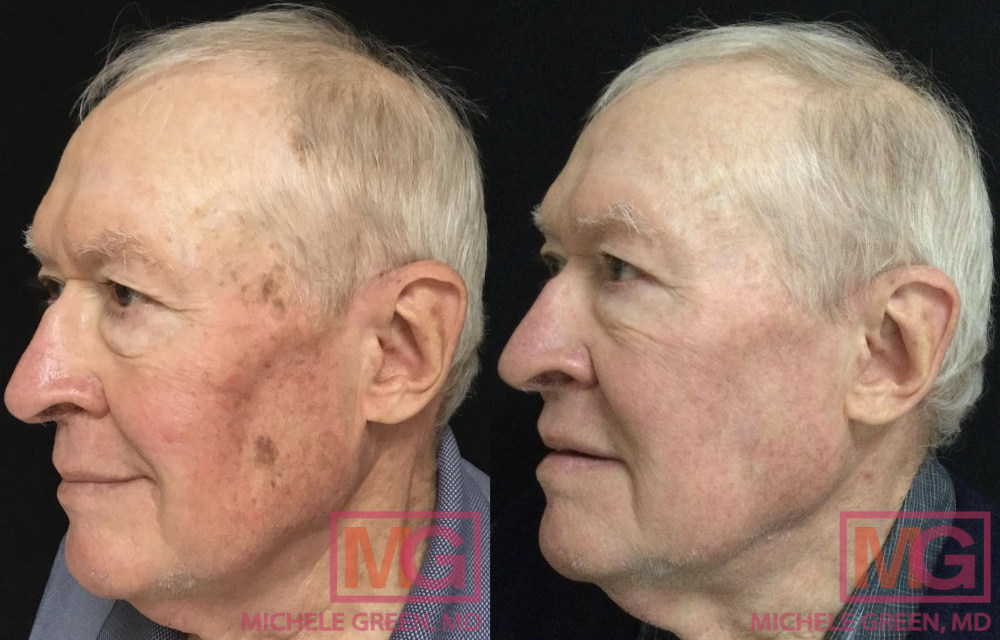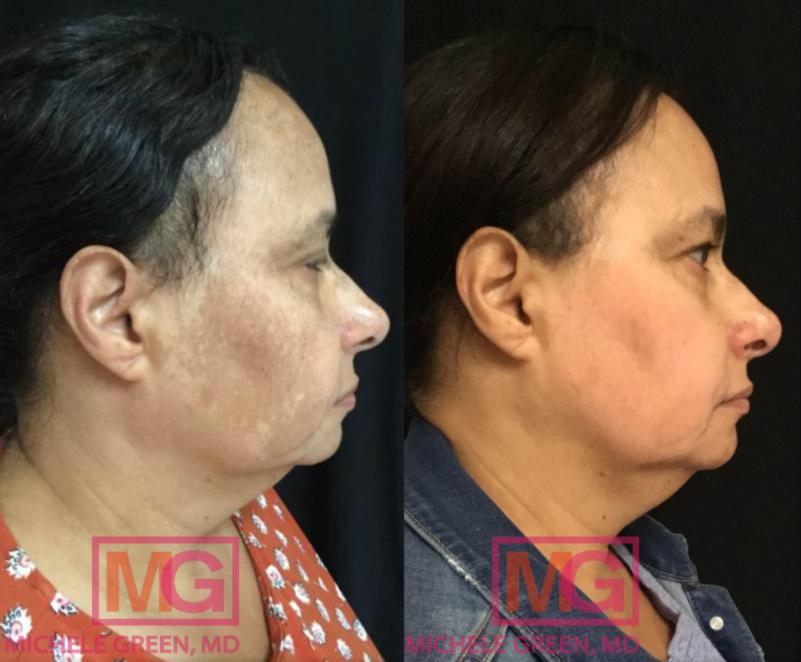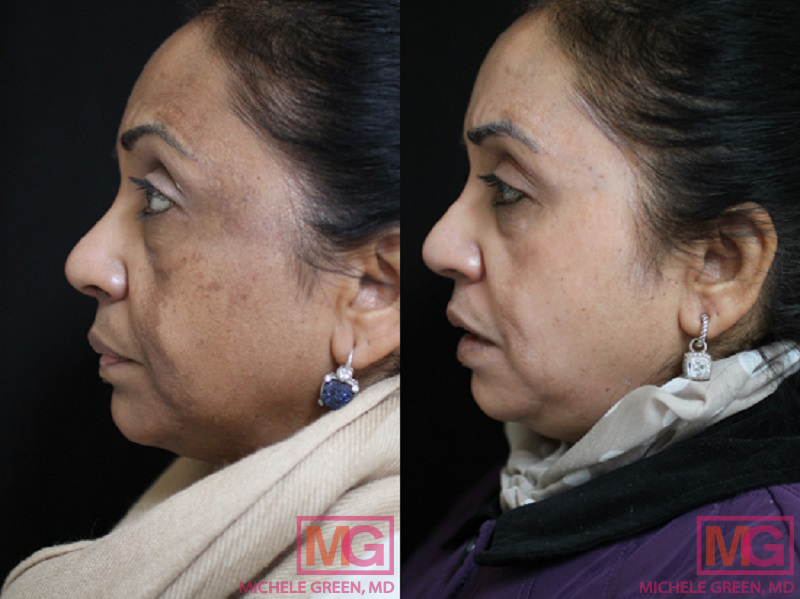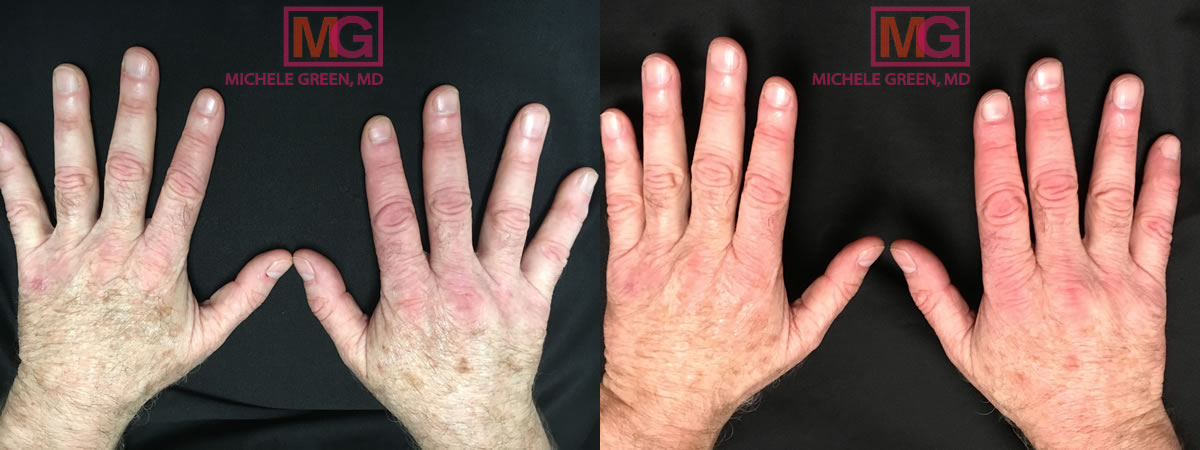What is the Difference Between Melasma and Sun Spots?
Melasma and sun spots are two distinct types of hyperpigmentation that can be exacerbated by sun exposure, making them especially difficult to differentiate without the help of an expert. However, understanding your hyperpigmentation type is essential for developing the right cosmetic and skincare treatment plan. Melasma is a common skin condition characterized by brown to grey-brown patches of skin that are darker in color than the surrounding skin. Sunspots are tan, flat, circular dark spots that are caused by cumulative sun damage and do not fade over time. A board-certified dermatologist like Dr. Green in New York City can properly diagnose your skin condition and recommend the specific treatment options best suited to your form of hyperpigmentation.
Although melasma and sun spots are both associated with discolored patches of skin, they are distinct skin conditions requiring different treatment approaches to resolve. Many non-invasive treatment options are available at Dr. Green’s to reduce hyperpigmentation from melasma and sun spots and restore an even-colored complexion, including specially formulated topical skin-lightening products, Chemical Peels, Cosmelan peels, and Microneedling with depigmentation serum. Sunspots can also be removed with various laser treatments. However, melasma should never be treated with lasers. Laser treatments can worsen the appearance of melasma and make it more difficult to remove successfully. Understanding the difference between these two types of hyperpigmentation is key to tailoring the best treatment plan for your skin, and Dr. Green is here to help.
Dr. Michele Green is an internationally renowned board-certified dermatologist with over 25 years of experience providing some of the world’s most discerning individuals with the best non-invasive cosmetic treatment options, including for addressing different types of hyperpigmentation. She is consistently identified as one of New York’s best dermatologists by Super Doctors, New York Magazine, Castle Connolly, and the New York Times for her dedication to her patients and expertise. When you consult with Dr. Green at her private dermatology office in Manhattan’s Upper East Side neighborhood, she will work with you to develop a customized treatment plan for your hyperpigmentation, depending on your skin type, form of hyperpigmentation, and skin tone so that you achieve a clear, radiant, healthy complexion that lasts.
What is melasma?
Melasma is a chronic skin condition characterized by brown or gray-brown patches of skin that commonly affect areas such as the cheeks, chin, forehead, nose, and upper lip. These patches are darker in color than the surrounding skin and develop due to overactive melanocytes. Melanocytes are skin cells that produce melanin or pigment. Melasma can fade and darken over time, typically darkening in the summer (with more sun exposure) and fading in the winter. Melasma may develop in individuals of any skin tone. However, it is more commonly seen in individuals with light to medium brown or darker skin tones because more melanocytes are available in the skin to synthesize large amounts of melanin.
There are three different types of melasma: epidermal, dermal, and mixed. Epidermal melasma involves the pigmentation occurring in the top layer of the skin (the epidermis) and appearing as dark brown patches of skin. In contrast, dermal melasma involves the pigmentation occurring in the middle layer of the skin (the dermis) and appearing more light brown or blue in color. Mixed melasma is the most common type, including a mixture of both epidermal and dermal melasma.
What are sun spots?
Sun spots are dark spots on the skin that develop due to frequent, excess, or cumulative sun exposure. Sun spots are also known as age spots, liver spots, or solar lentigines. Sun spots are flat, tan to brown, dark spots that are usually circular and can vary in size. They appear in areas often exposed to the sun’s UV rays, such as the arms, face, hands, and shoulders. Unlike freckles or sunburn, which tend to present immediately after sun exposure and gradually fade, these dark spots do not fade independently. In fact, sun spots can grow and darken over time with repeated sun exposure. Sun spots are common in individuals over 40 years old and those with fair skin; however, any individual exposed to excessive amounts of sun can develop this condition.

How can you tell the difference between melasma and sun spots?
With an untrained eye, melasma and sun spots can be very hard to distinguish from one another. Both skin conditions present with patches of hyperpigmentation caused by the increased production of melanin and worsened with sun exposure. Melasma typically manifests as brown to grey-brown dark patches and can appear symmetrical if it occurs on both sides of the face. Sunspots are usually not symmetrical in nature and can look like freckles or larger patches of skin discoloration. While sunspots develop specifically due to repeated sun exposure, melasma can develop due to pregnancy, hormone medications, thyroid disease, or genetic predisposition. Additionally, those who develop sun spots typically have a fairer skin tone than those who develop melasma.
Sun spots cannot fade naturally and require some intervention to reduce them, whether through topical serums and creams, chemical peels, or laser treatments. Typically, patients with melasma also need cosmetic treatments to reduce their hyperpigmentation successfully; however, if melasma develops due to pregnancy, oral contraceptives, or hormone therapies, it may resolve independently after pregnancy or discontinuing hormone medications. Patients with melasma should also never have laser treatment, as lasers may exacerbate the appearance of hyperpigmentation and cause melanin to embed itself in the deeper layers of the skin, making it more difficult to treat.
Is melasma sun damage?
Melasma is not the same as sun damage. Sun damage results from overexposure to UV rays from the sun and/or tanning beds, which causes DNA changes in the skin at the cellular level, potentially resulting in premature signs of aging and skin cancer. Some signs of sun damage include the appearance of fine lines and wrinkles, decreased elasticity, redness, hyperpigmentation, and uneven skin texture. Sun damage can’t be reversed but can be significantly improved with various non-invasive cosmetic treatment options. Melasma is a chronic skin condition that can be triggered or exacerbated by UV rays, but it is not the same as sun damage. Melasma is caused by various factors apart from the sun, including genetics and hormones, and requires different treatments than sun damage.
Does sun damage cause melasma?
The exact cause of melasma remains unknown, but certain factors are known to trigger or exacerbate the development of melasma. Sun damage is the most common trigger for melasma, as UVA and UVB rays stimulate the melanocytes in the skin to produce excess melanin. Improper sun protection or sun damage can worsen existing melasma, accelerate the development of melasma, or trigger the recurrence of melasma even after it has been cosmetically treated.
Sun damage, however, is not the only trigger for melasma development. Hormonal changes, including fluctuations in estrogen and progesterone, are thought to contribute to melasma. Melasma affects women nine times more than it does men. Women taking birth control pills or hormone supplements are at an even higher risk of developing melasma. Melasma is also called the “mask of pregnancy,” as many pregnant women tend to develop melasma due to the hormonal changes that occur.
In addition, thyroid disease has been linked with melasma. Serum TSH, anti-thyroid peroxidase, and anti-thyroglobulin antibodies are elevated in some patients with melasma. It is also thought that melasma has a genetic component, as many patients with melasma also have family members with the skin condition. Some oral medications have also been linked to melasma development.
Does melasma get worse in the sun?
Yes, melasma worsens with sun exposure. This is because the sun’s UV rays trigger the skin cells that produce melanin, the melanocytes, to produce more pigment. Melasma is a chronic skin condition, meaning that although melasma is treatable, it is not curable. Any form of sun exposure following melasma treatment can retrigger these cells to overproduce melanin. The best way to reduce the possible onset of melasma is to adhere to strict sun protection and discontinue using any medications or topical products that can create skin photosensitivity.
Will melasma go away?
Most patients will need some form of intervention, such as topical treatments, specially formulated skincare products, or chemical peels, to treat melasma. Some forms of melasma may go away on their own, depending on the cause of the melasma. For example, individuals who develop melasma due to hormonal changes during pregnancy or the use of oral contraceptive pills may find their hyperpigmentation resolves on its own once the pregnancy has concluded or after oral contraceptives have been discontinued. Other patients with melasma can find the best treatment options for their skin condition by consulting an expert, such as Dr. Michele Green in New York City.

Are sun spots hyperpigmentation?
Yes, sun spots are a form of hyperpigmentation. Hyperpigmentation is the broad term for any form of pigmented skin discoloration, including sun damage, melasma, and post-inflammatory hyperpigmentation (caused by acne breakouts, eczema, or a rash). Sun spots, however, are a type of hyperpigmentation caused specifically by sun damage.
Sun spot and melasma treatment
Many non-invasive treatment options are available for the skin discoloration seen in melasma and sun spots, including topical skin lightening products, chemical peels, Cosmelan peels, and microneedling with depigmentation serum. Additionally, those with sunspots can turn to various laser treatments. Melasma treatment should never involve lasers, as their use can embed pigmentation deeper into the skin and make melasma more difficult to remove. Consulting with a board-certified dermatologist is essential for ensuring that treating your type of hyperpigmentation is safe and effective. The most popular treatment options available at Dr. Green’s private dermatology office in NYC are described further in the following sections.
Skin care for hyperpigmentation
For patients experiencing hyperpigmentation, including melasma and sun spots, Dr. Green will employ a range of topical skincare products to use in conjunction with in-office treatment options to achieve a clear, healthy, radiant complexion that is long-lasting.
Sunscreen is crucial for preventing and reducing the appearance of hyperpigmentation. A broad-spectrum sunscreen is recommended to protect against both UVA and UVB rays. It is advised to layer two different types of sunscreens to ensure adequate protection. First, you should apply a chemical sunscreen that contains active ingredients such as avobenzone, followed by a physical sunscreen that contains zinc oxide or titanium dioxide. Ideally, a minimum of SPF 50 should be used daily and reapplied every ninety minutes or so, regardless of weather, as the sun’s rays can shine through clouds and bounce off rain puddles and snow. Additionally, sunscreen is essential indoors or in a car, as light can enter through glass panels.
Hydroquinone is an ingredient used in prescription skin-lightening creams to reduce hyperpigmentation. The strength of the hydroquinone can vary according to the pigmentation treatment plan created with your dermatologist. Other skin-lightening ingredients, such as cysteamine or tranexamic acid, may also be recommended as a bleach-free alternative.
Tretinoin, or Retin-A, is a vitamin A derivative topical cream that exfoliates the skin, sloughing off dead skin cells containing the excess pigment to reveal healthy, new skin cells underneath. This cream is available through prescription only; however, other retinol-containing products can be found over the counter at lesser strengths.
Chemical peels for hyperpigmentation
A chemical peel is a skin resurfacing treatment that increases the skin cell turnover rate to diminish sun damage and improve skin tone and texture. The acid in the chemical solution interacts with the outer layer of the skin to remove any dead skin cells and impurities, revealing healthy, new skin cells. Chemical peels are categorized by their depth- light, medium, and deep, and Dr. Green selects the strength of your chemical peel depending on your specific skin concerns and the type of hyperpigmentation assessed. Light or medium chemical peels are typically used for sun spots, while deep chemical peels are recommended for acne scarring, deep facial wrinkles, and improving skin texture. Dr. Green often recommends TCA or trichloroacetic acid chemical peels for those experiencing melasma. She may recommend chemical peels in combination with hydroquinone creams and tretinoin to diminish the appearance of hyperpigmentation. Mesopeels, another type of chemical peel, are also commonly used for hyperpigmentation and sun spots, as their specific formulation is gentle for sensitive areas, including around the eyes.

Cosmelan peel for melasma treatment
The Cosmelan peel is one of the most popular treatment options for melasma. Cosmelan is a professional-grade chemical peel mask that is applied by Dr. Green in the office and worn for several hours. The length of time you will be required to wear the mask is determined by your skin tone and the severity of your hyperpigmentation. After the designated amount of time has elapsed, the Cosmelan cream mask should be washed off at home with a gentle cleanser. In the following weeks, patients are given a skincare regimen of depigmenting and anti-aging products, including the Cosmelan 2 cream, Hydra-Vital factor K (vitamin K), and physical and chemical sunscreen. The Cosmelan 2 cream contains kojic acid, azelaic acid, vitamin C, retinoids, and hydroquinone, all ingredients that are key to further diminishing melasma, keeping the skin hydrated, and enhancing the effects of the Cosmelan peel over time. It is absolutely vital to continue proper sun protection after a Cosmelan peel, as hyperpigmentation can be worsened with sun exposure. When you have Cosmelan with Dr. Green, she will provide you with all the pertinent aftercare information required to achieve and maintain ideal results.
Microneedling with depigmentation serum
Microneedling, a treatment option also known as collagen induction therapy, is an excellent cosmetic procedure for improving overall skin tone and texture. Microneedling treatments can be paired with a specialized depigmentation serum to reduce the appearance of hyperpigmentation further and enhance the skin’s clarity and radiance. Microneedling involves the application of tiny, surgical-grade needles to the skin’s surface, which creates micro-wounds to the skin, jump-starting the body’s natural healing response to stimulate new collagen production and create new, healthy skin cells. The microchannels in the skin created by the microneedling device enhance the absorbency of the depigmentation serum, allowing for optimal effects. The depigmentation serum is then infused into the skin with each pass of the microneedling pen to treat pigmented cells and minimize the look of hyperpigmentation.
Laser treatments for sun damage
Candela Alex-Trivantage laser
The Candela Alex-Trivantage laser emits wavelengths of light that are absorbed into dark spots or sun spots. The light then transforms into heat and destroys the melanin in the skin cells, allowing for healthy, lighter skin cells to form. The surrounding skin is unaffected as this laser specifically targets melanin. This laser has little downtime, as a small scab may form at the site of the sun spots. The scab will heal within a week and show visibly reduced hyperpigmentation. Patients typically need one to two treatment sessions, with initial results visible one to two weeks after the procedure.
Fraxel laser
Fraxel is a skin resurfacing laser treatment designed to treat sun damage, brown spots, fine lines, and acne scars. The laser has two wavelength settings, 1927 and 1550nm, to target different skin conditions. The 1927nm is best for hyperpigmentation, while the 1550nm is best for improving overall texture. The two wavelengths can be used simultaneously to diminish the appearance of sun spots and eliminate other signs of aging, such as fine lines and wrinkles, to create a youthful, rejuvenated appearance. There is minimal downtime, with most patients experiencing side effects of mild redness and peeling for a few days following the treatment. It is essential to avoid sun exposure at this time to protect the new skin coming to the surface. Depending on the size of the areas and degree of hyperpigmentation, three treatments are generally needed one month apart to achieve the best cosmetic effects. The Fraxel laser is safest for patients with lighter skin tones; those with darker skin tones can use the Clear + Brilliant laser for similar improvements.
Clear + Brilliant laser
Dubbed the “mini-Fraxel” laser, the Clear + Brilliant laser is another resurfacing treatment that treats sun damage and sun spots to create an overall brightening effect on the skin. This fractionated laser creates microscopic facial injuries to remove dead, hyperpigmented skin cells and stimulate collagen production. This laser is safe for all skin types and can additionally improve skin tone, texture, and signs of aging, such as fine lines. There is no downtime from the procedure; five treatments a month apart are ideal for overall improvement.
Intense Pulsed Light (IPL)
The Intense Pulsed Light (IPL) laser treatment improves hyperpigmentation, brown spots, texture, redness, and fine lines. The laser emits several wavelengths of light that are converted to heat energy in melanin-rich cells. The heat then destroys the pigmentation in the cell, resulting in lightened skin. This treatment has no downtime or recovery, although you should continue to use proper sun protection as much as possible.
Is melasma just another word for sun spots?
Melasma is not another word for sun spots. While they both fall under the umbrella term of hyperpigmentation, they differ in causes and treatments. Melasma can be caused by internal factors such as hormones and genetics, while sun spots are caused by sun damage.
What is melasma vs sun spots?
Melasma is a common skin condition characterized by brown to grey-brown patches of skin that are darker in color than the surrounding skin. Sunspots are flat, circular brown spots that are caused by cumulative sun damage and do not fade over time. While sun damage can cause both melasma and sun spots to develop, melasma can be caused by other factors such as hormone imbalances, pregnancy, medication use, and genetic predisposition.

Skin care for hyperpigmentation at home
Sunscreen is the most important product to add to your skin care routine for hyperpigmentation. Sun exposure can trigger or exacerbate melasma and sun spots by stimulating melanocytes to produce more melanin. Using a broad-spectrum sunscreen with a minimum of SPF 50 is important for proper sun protection. Dr. Green recommends layering a chemical and physical sunscreen for maximum sun protection and reapplying every 90 minutes.
Retinol and retinoids are vitamin A derivatives that increase the rate of cell turnover. These ingredients slough off dead, hyperpigmented skin cells to reveal healthy new skin cells underneath.
Kojic Acid is a topical hyperpigmentation treatment that is naturally derived and inhibits over-active melanin production.
Azelaic Acid is a topical treatment that inhibits tyrosinase, an enzyme used in the first step of melanin production. Adding this treatment to your skin care routine will decrease melanin production and decrease overall hyperpigmentation.
Vitamin C is an excellent anti-oxidant that improves skin texture and tone and decreases the appearance of hyperpigmentation. Its antioxidant properties protect the skin from free radicals from the sun’s UV rays.
It is best to consult with a board-certified dermatologist like Dr. Green before adding skin-lightening skin care ingredients into your routine. During your consultation, she will assess the type of hyperpigmentation you have and tailor a home skin care regimen suited to your unique skin concerns and aesthetic goals.
How to get started with sun spot and melasma treatment today
Melasma and sun spots can appear as dark patches of skin and are worsened by excessive sun exposure. Although their presentation is similar, they are very different skin conditions that may require different treatments. It can be hard to differentiate between the two with an untrained eye, so it is important to consult a board-certified dermatologist such as Dr. Green to assess what type of hyperpigmentation is developing. There are many cosmetic treatments out there for melasma and sun spots, including topical creams, chemical peels, and laser treatments. The best treatment option for you will depend on your skin type and the type and severity of your hyperpigmentation.
Dr. Michele Green has over 25 years of experience providing her patients with the best non-invasive sun spots and melasma treatment options. Dr. Green is a world-renowned board-certified dermatologist with a particular interest in treating hyperpigmentation. She is consistently recognized by Castle Connolly, New York Magazine, Super Doctors, and The New York Times as one of NYC’s best dermatologists for her dedication to her patients and expertise. When you visit her private Upper East Side dermatology office for your initial consultation, she will listen to your specific skin concerns and aesthetic goals to create your individualized treatment plan. To get started with melasma or sun spot treatment today, schedule a consultation with Dr. Green by contacting us online or calling the NYC-based office at 212-535-3088.
 212-535-3088
212-535-3088